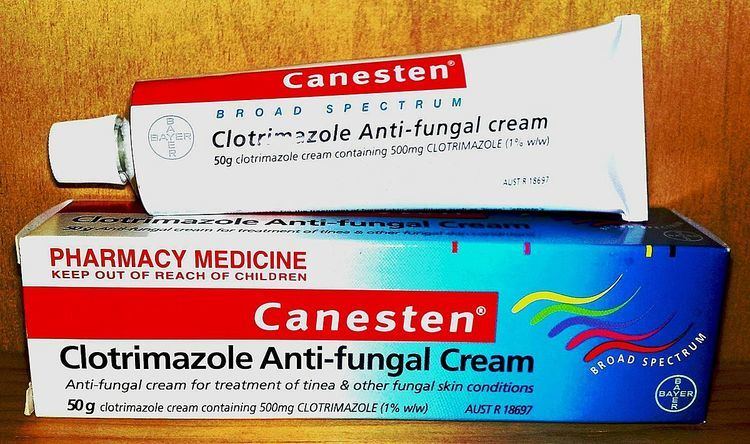 | ||
An antifungal medication is a pharmaceutical fungicide or fungistatic used to treat and prevent mycoses such as athlete's foot, ringworm, candidiasis (thrush), serious systemic infections such as cryptococcal meningitis, and others. Such drugs are usually obtained by a doctor's prescription, but a few are available OTC (over-the-counter).
Contents
Polyene anti fungals
A polyene is a molecule with multiple conjugated double bonds. A polyene antifungal is a macrocyclic polyene with a heavily hydroxylated region on the ring opposite the conjugated system. This makes polyene antifungals amphiphilic. The polyene antimycotics bind with sterols in the fungal cell membrane, principally ergosterol. This changes the transition temperature (Tg) of the cell membrane, thereby placing the membrane in a less fluid, more crystalline state. (In ordinary circumstances membrane sterols increase the packing of the phospholipid bilayer making the plasma membrane more dense.) As a result, the cell's contents including monovalent ions (K+, Na+, H+, and Cl−), small organic molecules leak and this is regarded one of the primary ways cell dies. Animal cells contain cholesterol instead of ergosterol and so they are much less susceptible. However, at therapeutic doses, some amphotericin B may bind to animal membrane cholesterol, increasing the risk of human toxicity. Amphotericin B is nephrotoxic when given intravenously. As a polyene's hydrophobic chain is shortened, its sterol binding activity is increased. Therefore, further reduction of the hydrophobic chain may result in it binding to cholesterol, making it toxic to animals.
Imidazole, triazole, and thiazole antifungals
Azole antifungal drugs (except for abafungin) inhibit the enzyme lanosterol 14 α-demethylase; the enzyme necessary to convert lanosterol to ergosterol. Depletion of ergosterol in fungal membrane disrupts the structure and many functions of fungal membrane leading to inhibition of fungal growth.
Imidazoles
Triazoles
Thiazoles
Allylamines
Allylamines inhibit squalene epoxidase, another enzyme required for ergosterol synthesis. Examples include Amorolfin, Butenafine, Naftifine, and Terbinafine.
Echinocandins
Echinocandins may be used for systemic fungal infections in immunocompromised patients, they inhibit the synthesis of glucan in the cell wall via the enzyme 1,3-Beta-glucan synthase:
Echinocandins are poorly absorbed when administered orally. When administered by injection they will reach most tissues and organs with concentrations sufficient to treat localized and systemic fungal infections.
Others
Adverse effects
Apart from side-effects like liver damage or affecting estrogen levels, many antifungal medicines can cause allergic reactions in people. For example, the azole group of drugs is known to have caused anaphylaxis.
There are also many drug interactions. Patients must read in detail the enclosed data sheet(s) of the medicine. For example, the azole antifungals such as ketoconazole or itraconazole can be both substrates and inhibitors of the P-glycoprotein, which (among other functions) excretes toxins and drugs into the intestines. Azole antifungals also are both substrates and inhibitors of the cytochrome P450 family CYP3A4, causing increased concentration when administering, for example, calcium channel blockers, immunosuppressants, chemotherapeutic drugs, benzodiazepines, tricyclic antidepressants, macrolides and SSRIs.
Before oral antifungal therapies are used to treat nail disease, a confirmation of the fungal infection should be made. Approximately half of suspected cases of fungal infection in nails have a non-fungal cause. The side effects of oral treatment are significant and people without an infection should not take these drugs.
Mechanism of action
Antifungals work by exploiting differences between mammalian and fungal cells to kill the fungal organism with fewer adverse effects to the host. Unlike bacteria, both fungi and humans are eukaryotes. Thus, fungal and human cells are similar at the biological level. This makes it more difficult to discover drugs that target fungi without affecting human cells. As a consequence, many antifungal drugs cause side-effects. Some of these side-effects can be life-threatening if the drugs are not used properly.
